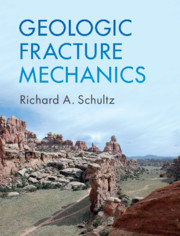Book contents
- Geologic Fracture Mechanics
- Geologic Fracture Mechanics
- Copyright page
- Dedication
- Contents
- Preface
- Acknowledgements
- 1 Introduction to Geologic Structural Discontinuities
- 2 Elastic Rock Rheology and Stress Concentration
- 3 Stress, Mohr Circles, and Deformation at Peak Strength
- 4 Cracks and Anticracks
- 5 Discontinuity Patterns and Their Interpretation
- 6 Faults
- 7 Deformation Bands
- 8 Fracture Mechanics: A Tour of Basic Principles
- 9 Beyond Linear Elastic Fracture Mechanics
- Glossary
- References
- Index
- Answers to Selected Exercises
6 - Faults
Published online by Cambridge University Press: 03 August 2019
- Geologic Fracture Mechanics
- Geologic Fracture Mechanics
- Copyright page
- Dedication
- Contents
- Preface
- Acknowledgements
- 1 Introduction to Geologic Structural Discontinuities
- 2 Elastic Rock Rheology and Stress Concentration
- 3 Stress, Mohr Circles, and Deformation at Peak Strength
- 4 Cracks and Anticracks
- 5 Discontinuity Patterns and Their Interpretation
- 6 Faults
- 7 Deformation Bands
- 8 Fracture Mechanics: A Tour of Basic Principles
- 9 Beyond Linear Elastic Fracture Mechanics
- Glossary
- References
- Index
- Answers to Selected Exercises
Summary
Faults are an efficient mechanism for allowing large strains to accumulate in the upper lithosphere of the Earth and other planetary bodies. In general, faults are arrays of 3-D surfaces along which large shear offsets (fault-parallel displacements) have been accommodated by frictional sliding (see Chapter 1). Faults can redirect the flow of subsurface fluids (either channeling or restricting the flow), modify the transmission of seismic waves, and create spectacular surface topography—through steady or destructive slip events—that have attracted mankind over millennia for the associated resources and natural beauty.
- Type
- Chapter
- Information
- Geologic Fracture Mechanics , pp. 209 - 264Publisher: Cambridge University PressPrint publication year: 2019

